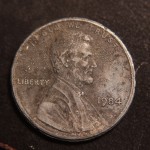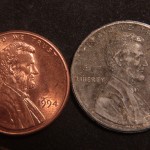This coin has a uniform grey color similar to a steel cent. I can't see any raised areas indicating chemical removal or electrolysis although there is some pitting. Never seen this before? Is somewhat "fuzzy", if you will, with the standard soft mid-80's strike.
1985-D? Un-plated or altered?
Collapse
X
-
Tags: None
-
If I could see some of the original luster, I would say that it might be a genuine unplated cent. Based on its condition right now though, I would lean more toward the plating was remove post mint.Bob Piazza
Former Lincoln Cent Attributer Coppercoins.com -
Check the diameter, Tracy. One of the common methods for de-plating involves expanding the diameter until the plating splits and can be removed.All opinions expressed are not necessarily shared by willbrooks or his affiliates. Taking them may result in serious side effects. Results may vary. Offer not valid in New Jersey.Comment
-
If possible I would check the weight also... It is only 2.5% of the total weight but that could give an indication of removal... For myself I would attempt to clean a small section of the edge... I have seen a few like this that were covered in some sort of gray dirt and when cleaning the edge the copper shows through!!!Jim
(A.K.A. Elmer Fudd) Be verwy verwy quiet... I'm hunting coins!!! Good Hunting!!!
Be verwy verwy quiet... I'm hunting coins!!! Good Hunting!!!
Comment
-
-
A hammer and 2 pieces of leather does the trick nicely.
Stripped Plating: When the copper plating is removed from the zinc core of a cent using chemical or mechanical means. This seems to be a popular science experiment in recent years. One must be careful to not confuse a stripped cent with a genuine unplated cent. The former is post-strike damage, while the latter is considered a mint error. A genuine unplated uncirculated cent will still have mint luster, while a stripped one will not. Also, some of the methods for stripping a cent, such as hammering it between leather to split the plating, will leave the cent with a larger-than-normal diameter, sometimes referred to as a “Texas cent.” For more information on stripped plating vs. unplated mint errors, see Jason Cuvelier’s tutorial Here.
Texas Cent: A cent that has been hammered between pieces of (usually) leather, creating a cent with a larger-than-normal diameter. This practice is often used on copper-plated zinc cents in order to split and remove the plating. Photos courtesy of jallengomez.

 Last edited by willbrooks; 02-09-2015, 08:24 PM.All opinions expressed are not necessarily shared by willbrooks or his affiliates. Taking them may result in serious side effects. Results may vary. Offer not valid in New Jersey.
Last edited by willbrooks; 02-09-2015, 08:24 PM.All opinions expressed are not necessarily shared by willbrooks or his affiliates. Taking them may result in serious side effects. Results may vary. Offer not valid in New Jersey.Comment
-
Weight & Dimensions
Diameter looks normal to me. Weight is 2.5. Edge color is uniform all the way around. Don't think this one has been hammered at least but dunno about chemicals/electrolysis. Should I rinse it to see if any luster remains?. It's somewhat dusty. Got this from a random bank brick if it matters.Attached FilesComment
-
Had to dig out a couple of mine to double check. Thanks Will very informative. Out here in the west we have all kinds of minerals in the area. We as kids took the 1943 and using waste water from the mines cold plate the cents Aluminum cans even some artisan wells. Geo thermal would strip most depending on location due to sulfides.Comment
-
The weight is not a factor for an unplated cent because the weight of the plating is not enough to put the coin out of tolerance. I'm one who also looks for luster on these.Comment
-
I've never heard of percussion or pressure and the associateed expansion being used to remove copper plating. I strongly doubt this is possible, since the plating is bonded to the zinc core. Since massively expanded reverse die caps show no interruption of the copper plating, this would seem to negate your suggestion. I assume the Texas cents you refer to have had their plating removed before or after the enlargement of the cent.Comment
-
Mike,I've never heard of percussion or pressure and the associateed expansion being used to remove copper plating. I strongly doubt this is possible, since the plating is bonded to the zinc core. Since massively expanded reverse die caps show no interruption of the copper plating, this would seem to negate your suggestion. I assume the Texas cents you refer to have had their plating removed before or after the enlargement of the cent.
I certainly see your point. I've seen centered broadstrikes of similar diameter with no breaks in the plating, but I've also seen numerous broadstrikes which did stretch the plating enough to cause breaks. However, every single cent that I have come across which is missing the plating, and there have been several, have all been larger in diameter. Also, the vast majority which are posted here, and on other forums, with questions regarding missing plating end up being larger in diameter. It's such a consistent occurrence, that there must be some causal connection between missing plating and a larger diameter. Even if the explanation of how this occurs is different from the popular theory, it seems that some process that is used to remove the copper plating is also causing the expansion of the coin. It would be interesting to pursue some experiments.Last edited by jallengomez; 02-10-2015, 09:11 AM.“What can be asserted without evidence can also be dismissed without evidence.”Comment
-
Could it be that the coin is first heated to break the bonding of the plating with the zinc core and then allowed to cool? This would allow the zinc core to retain the design features. After that, could pounding it out to a larger diameter break the plating and allow it to be peeled off?“What can be asserted without evidence can also be dismissed without evidence.”Comment
-
So, hypothetically speaking, if my coin is of normal weight and diameter yet exhibits little if any luster, where does this leave us? Sounds like a conspiracy to me!
Comment
-
Here is some nice photo and some explanation for you.
I f i I were to strip the copper of it could be done with just a high PH. lime caustic soda then neutralize with with distilled water or Hydrogen Peroxide. i Spent about 15 years running a recovery circuit for Precious metals Gold Silver ect . Electrowinning cells is how we collected and stripping depended on what type of rock. Cyanide was preferred.Comment




Comment